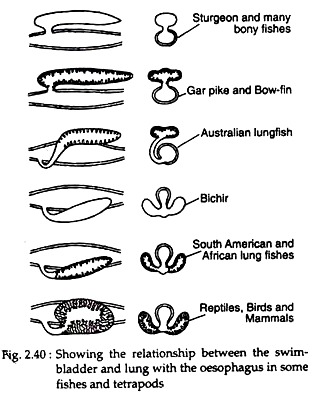In this article we will discuss about:- 1. Meaning of Weberian Ossicles 2. Mode of Action of Weberian Ossicles 3. Functions.
Meaning of Weberian Ossicles:
The perilymphatic sac and the anterior end of the swim-bladder are connected by a series of four ossicles (Fig. 2.40) which are articulated as a conducting chain. Of the four, the tripus, intercalarium and scaphium actually form the chain, while the fourth one, claustrum lies dorsal to the scaphium and lies in the wall of posterior prolongation of the perilymphatic sac.
The function of these ossicles is controversial. It is regarded that the Weberian ossicles either help to intensify sound vibrations and convey these waves to the internal ear, which help to understand the state of tension of air pressure in the bladder and transit changes of such pressure to the perilymph to set up a reflex action.
There are various views regarding the actual process of derivation of these ossicles. It is believed that these ossicles are detached or modified processes of the first three anterior vertebrae. As regards the actual mode of origin of the four ossicles there are differences of opinion.
ADVERTISEMENTS:
The claustrum is regarded to be modified inter-spinous ossicle or modified spine of first vertebra or modified neural arch of first vertebra or modified intercalated cartilage or modified neural process of first cartilage. The scaphium is considered to be the modified neural arch of the first vertebra or modified rib of the first vertebra or derived from the neural arch of the first vertebra and also from the mesenchyme.
The intercalarium is derived from the neural arch and transverse process of the second vertebra or from the neural arch of the second vertebra and also from the ossified ligament or from the neural arch of the second vertebra only.
The tripus is formed from the rib of the third vertebra and the ossified ligament or from the transverse process of the third vertebra along with ossified wall of the swim-bladder or from the transverse process of the third vertebra and the ribs of third and fourth vertebrae.
Mode of Action of Weberian Ossicles:
ADVERTISEMENTS:
There are two modes of action in different fishes:
1. Direct mechanical transmission of the vibrations.
2. Indirect system of transmission.
A change in the volume of the bladder causes its walls to bulge out of the opening and forces the ossicles forwards. In the indirect system of the cyprinoids, a backward movement of the posterior process of the tripus causes its anterior movement.
ADVERTISEMENTS:
The movements of the ossicles cause an increase in the pressure of the perilymph in the sinus in-par, which is conveyed to the sacculus. Thus, the vibrations of the gas bladder wall are transmitted to the ear by changes in tension. In direct system (Siluroids), the swim- bladder is enclosed in a bony capsule and protrudes through an opening in it for attachment with the tripus.
Functions of the Weberian Ossicles:
The ossicles appear to perform a variety of functions:
1. As pressure register:
They are sensitive to changes in the volume of the swim-bladder due to variations in the hydrostatic pressure. Any change in the volume of the swim-bladder causes movements of the sinus impar. This is then conveyed to the sacculus through the endolymph of the transverse canal.
2. As barometer:
It is presumed that fish can detect variation in the atmospheric pressure through Weberian ossicles.
3. As auditory organ:
ADVERTISEMENTS:
The ossicles transmit the vibrations of the bladder wall to the perilymph of sinus impar. The vibration reach the saccular otoliths via endolymph.
4. As sound locator:
The vibrations received on the side of the bladder nearest the source are stronger than the other side.
